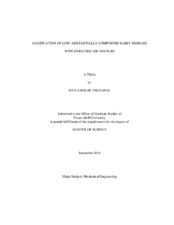| dc.contributor.advisor | Annamalai, Kalyan | |
| dc.creator | Thanapal, Siva Sankar | |
| dc.date.accessioned | 2012-02-14T22:18:59Z | |
| dc.date.accessioned | 2012-02-16T16:13:38Z | |
| dc.date.available | 2012-02-14T22:18:59Z | |
| dc.date.available | 2012-02-16T16:13:38Z | |
| dc.date.created | 2010-12 | |
| dc.date.issued | 2012-02-14 | |
| dc.date.submitted | December 2010 | |
| dc.identifier.uri | https://hdl.handle.net/1969.1/ETD-TAMU-2010-12-8927 | |
| dc.description.abstract | Biomass is one of the renewable and non-conventional energy sources and it includes municipal solid wastes and animal wastes in addition to agricultural residue. Concentrated animal feeding operations produce large quantities of cattle biomass which might result in land and water pollution if left untreated. Different methods are employed to extract the available energy from the cattle biomass (CB) which includes co-firing and gasification. There are two types of CB: Feedlot biomass (FB), animal waste from feedlots and dairy biomass (DB), animal waste from dairy farms. Experiments were performed in the part on gasification of both FB and DB. Earlier studies on gasification of DB with different steam-fuel ratios resulted in increased production of hydrogen. In the present study, dairy biomass was gasified in a medium with enriched oxygen percentage varying from 24% to 28%. The effect of enriched air mixture, equivalence ratio and steam-fuel ratio on the performance of gasifier was studied. Limited studies were done using a mixture of carbon dioxide and oxygen as the gasification medium and also a methodology was developed to determine the gasification efficiency based on mass and heat contents of gas. The results show that the peak temperature within the bed increases with increase in oxygen concentration in the gasification medium. Also carbon dioxide concentration in the mixture increases with corresponding decrease in carbon monoxide with increase in oxygen concentration of the incoming gasification medium. The peak temperature increased from 988°C to 1192°C as the oxygen concentration increased from 21% to 28% at ER=2.1. The upper limit on oxygen concentration is limited to 28% due to high peak temperature and resulting ash agglomeration. Higher heating value (HHV) of the gases decreases with increase in equivalence ratio. The gases produced using carbon dioxide and oxygen mixture had a higher HHV when compared to that of air and enriched air gasification. Typically the HHV of the gases increased from 2219 kJ/m³ to 3479 kJ/m³ when carbon dioxide and oxygen mixture is used for gasification instead of air at ER=4.2 in the absence of steam. | en |
| dc.format.mimetype | application/pdf | |
| dc.language.iso | en_US | |
| dc.subject | Gasification | en |
| dc.subject | Enriched air | en |
| dc.subject | Dairy biomass | en |
| dc.subject | Higher heating value | en |
| dc.title | Gasification of Low Ash Partially Composted Dairy Biomass with Enriched Air Mixture | en |
| dc.type | Thesis | en |
| thesis.degree.department | Mechanical Engineering | en |
| thesis.degree.discipline | Mechanical Engineering | en |
| thesis.degree.grantor | Texas A&M University | en |
| thesis.degree.name | Master of Science | en |
| thesis.degree.level | Masters | en |
| dc.contributor.committeeMember | Petersen, Eric L. | |
| dc.contributor.committeeMember | Capareda, Sergio C. | |
| dc.type.genre | thesis | en |
| dc.type.material | text | en |


